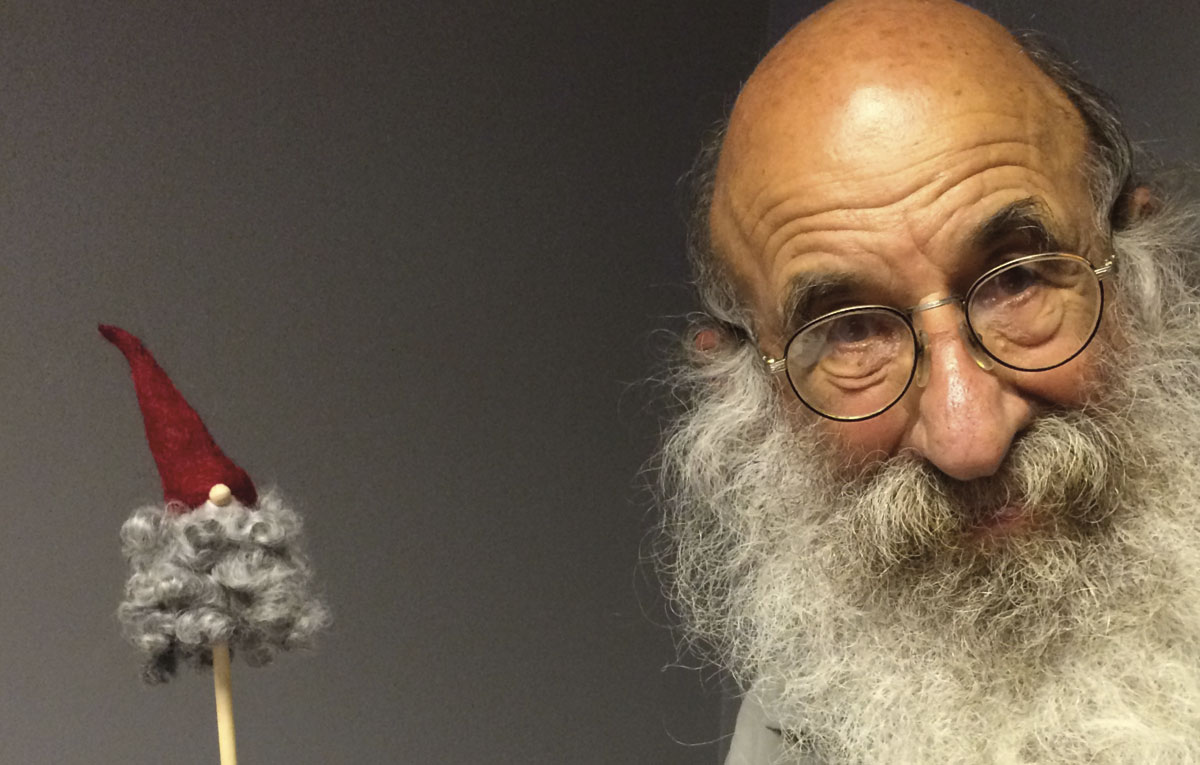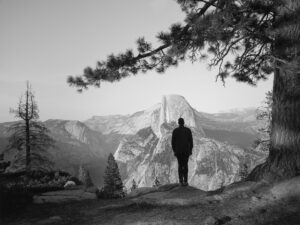“Hey, do you know this story?” This is Malcolm Margolin’s throat clear, his way of checking in with you to let you know a memory is coming. (I wonder if anyone ever says yes.) “There’s a marvelous line,” he’ll say, and then you’re off with a poet laureate, or a Kashaya Pomo healer, or Gandhi’s grandson. The legendary Heyday Books publisher and Bay Nature co-founder, who retired earlier this year, has 46 years of California stories to tell, and says even in retirement he plans to continue to telling them “to anyone who will listen.” From the table at the Heyday office in Berkeley where he’s edited so many manuscripts—next to his cleared-out office—Margolin talked with me about nature, California, beauty, and of course, storytelling.
Eric Simons: At the end of The Ohlone Way you write, “The irony is that while we look forward to a dimly perceived future when such values might be realized, we have failed to understand that they existed in the not-so-distant past as the accomplishments not only of the Ohlones, but of Stone Age people the world over.”
Malcolm Margolin: When the first Spaniards came up the coast, they were coming through all these Indian territories. They were starving and sick. Rations were reduced to five moldy tortillas a day, and they had begun killing the mules for food. Every morning before setting out, the priest would gather the “crew of skeletons” together and recite the Viaticum, because they expected somebody would die later in the day. Yet all around them were Indians living in relative prosperity. For me, this is a great metaphor. That all around us in these Indian cultures are things we can use, keys to a fuller way of living, ideas that can enlighten us, practices that can transform our daily life, stories that can enlarge our compassion and stimulate our imagination. There’s a hint of how to be human beings in a different way. But it’s encoded in another language, encased in another culture. Traditional Indian life was so different from our life today that we have trouble even imagining that we could learn from them. But we not only can, I feel we must, and now that I’ve got time I’ve begun working on a book about what Indians can teach us, and after the book is out, I’d like to get together with others not just to study Indian life, but to figure out how to incorporate aspects of it into our culture.

ES: People understand the world around them through stories. If you extend your metaphor, those bedraggled Spaniards coming up the coast, they didn’t—couldn’t—see the story there. I wonder if we’ve reached that point where these cultures, whose values we can intellectually write down, are such a foreign story to us that we can’t recognize it.
MM: Well, these stories are indeed foreign. I’m fond of quoting those wonderful lines by the poet W. S. Merwin, “I want to tell what the forests were like/I will have to speak in a forgotten language.”
This is an election year, and while there are clearly differences between those running for office, every one of them—from the ultraliberal to the ultraconservative—seems locked in the same mind-set: Economic prosperity, defined by material wealth and an ever-growing economy, is not only the ultimate good but the birthright of every American. Am I the only one who yearns for better stories, for a more capacious vision of what it means to be human? Someone, I forget who, once defined insanity as having only one story. To equate happiness so exclusively with the accumulation and individual ownership of material goods is a failure of imagination. And the imagination is where the battle for a healthy environment needs to be fought. If we win in the courts, win in the legislature, create a thousand new national parks, and put hundreds more plants and animals on the endangered species list, but lose the battle for the human imagination, whatever victories we achieve will be temporary.
Am I the only one who is becoming increasingly uneasy with a movement that embraces fixity, preserving species and habitats with great effort and at almost any cost, while often denying the inevitability of change? I was in Hawaii a while ago, and I was at the top of this mountain in Oahu where they’re preserving a snail. The amount of effort taken to preserve this snail is nothing short of monumental. It’s a snail! I wish it well. I’m sorry it’s going extinct, I wish it weren’t, and I respect the impulse to save it. But can we really guarantee every species eternal existence? While I agree that we need to expend effort to preserve species and habitats whenever possible, our greater and more challenging responsibility is to preserve the underlying capacity of this world to be fertile, to be beautiful, to change. Change is the great force in the world, inevitable and built deeply into the basic processes of all life. There’s a word in the English language for things that don’t change: dead. Fighting change is fighting life, and in the end it’s a losing battle.
ES: Is there a secret, then, to falling in love with something and accepting that it will change or even disappear? I mean, I love fog. Scientists tell me it’s disappearing because of climate change. That change makes me unhappy.
MM: Whoever gave you the idea that falling in love is connected to happiness? Sure, sometimes it leads to the profoundest happiness a person can know. Other times it leads to unfulfilled yearning, at times to the deepest sadness. If fog is indeed disappearing, a case can be made that this makes fog all the more precious and worthy of love. Should we stop loving wildflowers because they are ephemeral? Should we stop loving each other because death is inevitable? There’s that wonderful haiku by Issa, “This world is but a dewdrop world. And yet…”
We fall in love when we see the beauty and wondrousness of the other, and that beauty breaks down the door to the heart, leaving us open and vulnerable. We fall in love because we have no choice—it’s the tribute we pay to the world, the price of being fully alive—and we need to accept the consequences.

ES: You speak often of your search for beauty. But that means something different for you, I think, than for most people. You open East Bay Out with a beautiful essay about Bishop Ranch in San Ramon. Wonderments of the East Bay celebrates the beauty of seeds and rock walls. While maybe for most people natural beauty is more like grandeur, starting at Yosemite and falling off from there—not, in any case, to be found in commonplace species or regional parks.
MM: I talk, think, and write about beauty all the time. Let me read you something that my youngest son, Jake, said about his upbringing.
“My parents always looked at the world through a lens of beauty, whether it was in the relationship with the people they knew, or the gardening that my mother was doing, or the cards we’d make for each other. For both of my parents, their highest level of praise for something that someone said or for a story or an action was ‘Oh, that’s beautiful.’ Beauty in a very broad sense. Beauty above all else: That was instilled in me and in all of us as the goal of life, to identify the beautiful things in the world and then be near them, gather them around you, appreciate them, and pass them on to others.”
My main skill is not the creation of beauty; it’s the recognition of beauty in the world around me, and that includes the beauty of the human race. I find beauty everywhere, because it is everywhere, and my skills are the skills not of a creator but of a good witness.
As for grandeur, I love it, and of course I’m much more profoundly moved by Yosemite than I am by Tilden or Bishop Ranch. But I do find beauty and wonderment everywhere. Perhaps the reason I seem to have this ability to recognize the beauty of the everyday is that I’ve spent almost all my life without a TV, I don’t carry a cell phone, I don’t go to many movies, my head is not filled with advertising slogans, and I read a lot of good literature and poetry. I lead a busy social life, working with others and going to parties, but I daydream a lot and I’m not fighting sensory overload. There’s a poem by William Everson, also known as Brother Antoninus, with the haunting line “The nerve that is dying needs thunder to rouse it.”
ES: One of the things they talk about in writing classes is that when you write in the first person, you have to answer the question, “Who am I?” Because you’re never fully authentic. Who is the character Malcolm Margolin, and how does it compare to real-life Malcolm?

MM: There’s this great story that I heard about Phil Levine. Phil lived in Fresno, where he created a world-class poetry scene, and was at one time Poet Laureate of the United States. He was at some kind of conference where poets were discussing poetry, saying things like how with poetry you can be “your real self.” Phil looks around with total disgust and says, “Why be your real self when with a little effort you can be interesting?”
Of course I’ve created the character that I am in the pages of the books that I’ve written, the public self that I present to the world. I guess it’s something of a pose. But it’s a good pose. It’s a pose that makes me happy, a pose that makes me productive, and other people seem to like it as well. More importantly, it’s a pose that lets the people around me flourish. I think that’s essential, that people around you flourish. I guess the Malcolm character is a being of my own invention, put together from role models, aspirations, a desire to impress, a desire to shed childhood fears, shames, self-doubts, but I think that’s the way we grow. We put forth an image, not of who we are, but of who we’d like to be, try it on like a suit of clothes, and if we like what we see in the mirror that’s who we become.
That said, I think it’s necessary not to be conned by your own act. There’s that chilling observation by La Rochefoucauld, “We are so accustomed to disguise ourselves to others that in the end we become disguised to ourselves.” I once had a very clear image of how the character I’d invented relates to the inner self. I was at an elegant party or reception, great wine, delicious food, gorgeous women, world-famous artists, poets, and innovators, an assemblage of some of the world’s most interesting and accomplished people. And I was in top form—witty, telling great stories, the center of attention and the object of admiration. As I was carrying on, my gaze wandered off to a corner of the room where a morose, badly dressed, shy, awkward, and very much alone character was staring at me. “What the hell are you doing here?” I said. “I thought I got rid of you years ago.” He looked at me sadly, and with a voice full of love and tenderness, he said, “You’ve gone far in your life, but please don’t forget about me. I’ll always be in a corner somewhere, and you need me for the fullness of your humanity.”





